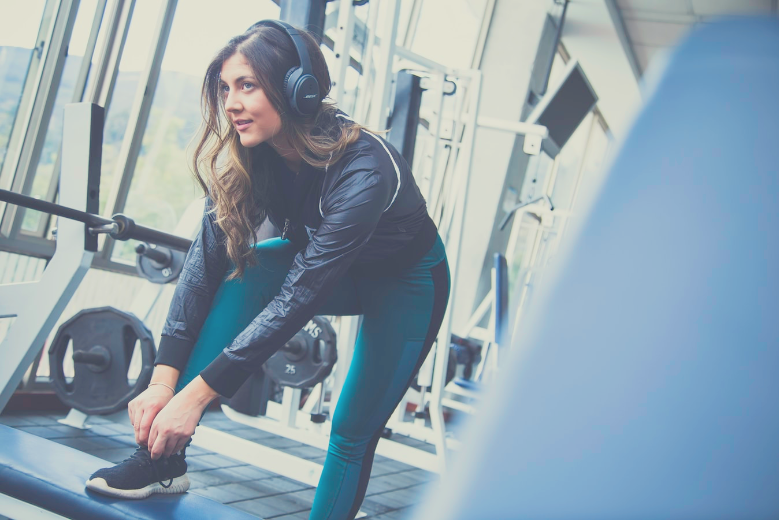When I hit a plateau in my weight loss goals, I needed a workout to push me through.
An HIIT workout, also known as High Intensity Interval Training (HIIT) workout, helped me break through my fitness plateau and also reaffirmed my commitment to exercise and staying healthy.
Plus, I can perform a HIIT workout with or without equipment, so it’s a super convenient way for me to get a quick workout in.

What is an HIIT Workout?
HIIT is a workout training technique that alternates intervals of rest or low intensity with intervals of high intensity exercises. HIIT stands for high intensity interval training. The intensity level corresponds to how difficult the exercise feels.
A high intensity level feels as if you do not want to continue it for long. You will feel slightly breathless and are unable to carry on a conversation. If you are able to have a conversation, the workout intensity level is not high enough.
During the recovery intervals of lower intensity, you should feel your heart and breathing rates slowing down. You will be able to talk, but not able to sing. If you are able to sing, increase the intensity slightly.
Another way to measure workout intensity is to monitor your exercise heart rate. During the high intensity intervals, aim to increase your heart rate between 90 and 95 percent of your maximum heart rate, MHR.
Calculate your high intensity interval heart rate by subtracting your age from 220. Then, multiply the result by 90 percent. For example, 220 minus 40 equals 180. 180 multiplied by .90 equals 162. 162 beats per minute is the high intensity interval target heart rate goal for a 40-year-old who participates in HIIT.
Wearing a heart rate monitor is the easiest way to keep track of your heart rate since HIIT training intervals are quick.
However, if you do not have a heart rate monitor, simply track your pulse on the thumb side of your wrist. Use the first two fingers on your opposite hand to find the pulse.
Then, count the number of beats you feel in 10 seconds. Multiply that number by 6 to calculate your workout beats per minute.
Who is HIIT for?
HIIT is for most people who participate in exercise. If you are new to fitness, you may want to limit the number of HIIT workouts you perform each week, or start with two to three intervals instead of a complete workout.
Always seek the advice of your doctor before beginning any new workout program, especially if you have a pre-existing condition such as heart disease.
HIIT is for physically active non-athletes searching for a workout to take them beyond workout plateaus. For instance, if you participate in a weekly exercise regimen, but are not reaching your fitness goals, a HIIT workout is for you.
A HIIT workout is also for people seeking weight loss, muscle gains, an increase in metabolism and a decrease in cholesterol. If you have any health concerns, HIIT workouts improve your overall well being and can reduce risk factors such as excess weight and high cholesterol.
HIIT workouts are also for athletes who want to take their performance to the next level. For example, if you play soccer but notice a decrease in your stamina, HIIT workouts help improve your endurance.
If you are a runner and want to improve your time, add two HIIT workouts to your weekly routine and notice the difference.
What are the Benefits of HIIT?
Along with providing an alternative workout program, which can help reduce workout boredom, HIIT has other benefits.
Saves Time
Interval workouts are designed to maximize fitness benefits in a short amount of time. Instead of performing moderate intensity exercise at a consistent level for a set duration such as 30 to 45 minutes, HIIT can be effective in workouts of 20 to 30 minutes.
Plus, according to the American Council on Exercise, HIIT training shows results sooner than traditional, continuous, moderate intensity training. In other words, you save time and reach your goals quicker.
Metabolism
Metabolism is the way a body changes food into energy. When people say they have a slow metabolism, they are typically referring to a body that burns a smaller amount of calories at rest.
Those with higher metabolisms, appear to convert food into energy quickly and use the energy for physical activity. One way to speed up metabolism is through an increase in muscle tissue.
Muscle tissue requires more calories to sustain itself, so the more muscle tissue in a body, the higher one’s metabolism. HIIT, especially when resistance exercises are included, increase muscle tissue and as a result, improve metabolism.
Fat Loss
During exercise, calories are converted into energy for the workout. During HIIT, the body requires a greater amount of calories, which can lead to additional fat loss. Plus, when the workout intensity level is high, your body enters a “fight or flight” response. This is due to the stress on your body.
When this happens, the body releases two hormones, epinephrine and norepinephrine, which cause more fat to be released during the workout.
In addition, through high intensity interval training, the workout places your body in a position through which you continue to burn calories after the workout. Therefore, HIIT enhances your fat loss.
Endurance
The high intensity intervals of HIIT improve endurance through a variety of changes that occur in the body. First, when you perform a workout near your maximum heart rate, the heart adjusts by pumping out more blood with each beat.
This allows greater and faster circulation of oxygenated blood to your working muscles. Over time, the heart adjusts to this increased output, and calls upon this strength when required for endurance events.
Second, changes occur at the cellular level which boost a cell’s ability to convert oxygen into energy. As the cells become more competent in the energy conversion, endurance improves.
Muscle Gain
HIIT stimulates muscle growth from its high demands on the muscles. When you exercise at high intensity levels, you are challenging your muscles with an increased stimulus.
Muscles respond to the increase in stimulus with an increase in the size and strength of muscle fibers and an increase in the number of muscle cells.
Cholesterol
As you participate in HIIT workouts and use fat for fuel, your cholesterol level decreases. A decrease in cholesterol is also typically seen following weight loss, which HIIT brings.
Blood Glucose
High levels of glucose in the bloodstream may signal diabetes. One of the goals of exercise for people with diabetes is to remove the glucose from the blood and increase the cell’s ability to absorb it.
When glucose is in the cells, it is used as energy for physical activities. HIIT has been shown to improve this cellular glucose absorption which leads to decreased blood sugar levels.

How to Get Started with HIIT
If you have never exercised before, begin with 20 to 30 minutes of consistent movements such as walking, cycling, or swimming. Perform your chosen exercise three to five days a week for one to two weeks to prepare your body for a more intense workout program.
If you are currently participating in exercise, plan to add HIIT to your routine on one or two days a week. Then, you need to determine whether your workout will use equipment or your body.
Have equipment available, such as dumbbells, a weight bench, or an exercise ball and clear an area in which you will be able to perform large movements such as jumping jacks and push-ups.
Wear supportive shoes to protect your back and the joints of your lower body. Wear comfortable clothing that lets you move freely and lets your body breathe.
Keep water on hand to stay hydrated while you exercise. You also need a timer with a second hand to keep track of your work and rest intervals.
Always begin your HIIT workouts with a warm up of approximately 5 minutes. Perform large body movements such as stair climbing, walking, marching in place, or dancing to increase circulation throughout your body.
During your warm-up, aim to increase your heart rate between 50 and 60 percent of your maximum heart rate. This is not a time to perform the high intensity intervals.
Building a HIIT Workout
Create your HIIT workout based on the exercises you enjoy, what equipment is available, and your desired fitness goals. Always begin with a five-minute warm-up to slowly elevate your heart rate and prepare your body for the HIIT session.
HIIT on a Treadmill
A sample HIIT workout using a treadmill, looks this like:
- 5 minute warm-up walk at 50 to 60 percent of maximum heart rate, MHR
- 30 second sprint at 90 to 95 percent of MHR
- 30 second slow recovery walk at 50 to 70 percent of MHR
- 30 second spring at 90 to 95 percent of MHR
- 30 second slow recovery walk at 50 to 70 percent of MHR
- Repeat the spring/rest intervals 6 to 8 more times.
- Cool down with a 5 minute walk to gradually decrease your heart rate.
The above treadmill pattern can be used on various cardio equipment. For instance, sprint and walk on an elliptical machine, or fast and slow pedal on an indoor cycle. If the 30-second intervals feel too short, increase the duration of each between 1 and 4 minutes.
If the 30-second intensity intervals feel too long, decrease the duration to 15 seconds until you feel comfortable performing the high intensity exercise for 30 seconds.
Gradually increase the duration of the high intensity intervals as your fitness level improves. Aim to keep the rest intervals the same or longer than the high intensity intervals.
Bodyweight Exercises & HIIT Workout
A sample body weight HIIT workout looks like this:
- Walk in place or around the room for a minimum of 5 minutes.
- Perform jumping jacks for 30 seconds. Rest for 30 seconds. Repeat.
- Squat for 30 seconds. Rest for 30 seconds. Repeat.
- Keep your feet together and jump side to side for 30 seconds. Rest for 30 seconds. Repeat.
- Perform sit-ups for 30 seconds. Rest for 30 seconds. Repeat.
- Jump rope, or pretend, for 30 seconds. Rest for 30 seconds. Repeat.
- Lunge for 30 seconds. Rest for 30 seconds. Repeat.
- Perform burpees for 30 seconds. Rest for 30 seconds. Repeat.
- Perform toe raises for 30 seconds. Rest for 30 seconds. Repeat.
- Perform mountain climbers for 30 seconds. Rest for 30 seconds. Repeat.
- Hold a plank position for 30 seconds. Rest for 30 seconds. Repeat.
- Cool down with a five-minute walk and then stretch for a 30-minute workout. You can also repeat the entire session or increase the duration of the intervals for a longer workout session.
If you have access to exercise equipment, or belong to a gym, prepare your HIIT workout in advance and have your equipment near you. Use the above pattern, but replace exercises such as lunges with dumbbell bicep curls. Or switch planks for exercise ball crunches.
The ways to arrange your HIIT workout are up to you. Use movements you enjoy so you want to continue to use your HIIT workouts weekly.

HIIT Workout Using Equipment
A sample equipment-based HIIT session looks like this:
- Walk for five minutes on a treadmill or up and down stairs.
- Sprint on the track for 60 seconds. Walk for 60 seconds.
- Perform dumbbell shoulder presses for 60 seconds. Walk toward the cardio machines for 60 seconds.
- Sprint on the elliptical for 60 seconds. Take 60 seconds to walk to the weights.
- Perform a bench press for 60 seconds. Walk for 60 seconds to the cardio equipment.
- Perform a seated sprint on the exercise bike for 60 seconds. Walk for 60 seconds to the weights.
- Perform dumbbell bicep curls for 60 seconds. Use 60 seconds to walk to the cardio equipment.
- Sprint on the stair climber for 60 seconds. Walk for 60 seconds to the weights.
- Perform barbell squats for 60 seconds. Take 60 seconds to walk to the cardio machines.
- Sprint on the treadmill for 60 seconds. Walk for 60 seconds to the weights.
- Perform back pull-downs for 60 seconds. Walk for 60 seconds to the track.
- Sprint for 60 seconds. Walk for 60 seconds to the weights.
- Cool down with a five-minute walk on the track and then stretch.
Vary the order of the workout to challenge your body or add in other exercise to reach the body parts you feel need more work.
The key is to arrange your HIIT session in a way that elevates your heart rate for an extended duration, followed immediately by an intensity level that decreases your heart rate.
The peaks and valleys of your heart rate during this interval session are the keys to receiving the workout benefits.
Much like with other exercise routines, your body will adjust to HIIT. As you feel the improvements, challenge your body by adding new exercises in or increasing the duration of the intensity levels.
HIIT is also challenging when you complete the workout with a partner or a friend. You motivate each other to do your best and keep up the high intensity workout levels.
Summary
HIIT combines intervals of high intensity exercise with intervals of lower intensity intervals. HIIT provides workout variety to push you past workout plateaus and also to reduce workout repetition boredom.
HIIT workouts also enhance weight loss, increase metabolism, improve cardiovascular health, and can aid in your body’s ability to reduce blood sugar levels.
They are an efficient workout for busy professionals or parents, or don’t have time in their day for an extended session of exercise. Plus, HIIT workouts can be performed at the gym using a variety of equipment, at home with, or without equipment or while traveling.
When arranging your HIIT workouts and adding them to your existing fitness schedule, keep the following in mind:
- Workout frequency– if you are a beginner, at one HIIT workout weekly. For those who are advanced perform two or three HIIT workouts a week, but schedule your workouts with a day in between. On those off days, continue to perform other workouts such as continuous cardio or strength training.
- How much– aim to increase your heart rate between 90 and 95 percent of MHR when you are performing the high intensity intervals. For your recovery intervals, aim for a heart rate between 50 and 70 percent of your MHR.
- How long– Select intervals between 30 seconds and four minutes. Keep your recovery intervals equal to or longer than the high intensity intervals.
As you experience the gains from HIIT, continue to challenge your body either through changing the exercises, increasing the duration of the high intensity levels, or adding more repetitions of the intervals.
I hope you find the same benefits I did through High Intensity Interval Training (HIIT) workouts. I was able to overcome my workout plateaus and renew my interest in my workout routines by mixing HIIT into what I was already doing.
Simply by adding one or two HIIT workouts a week, my body saw changes including muscle gains. Now, HIIT is part of my weekly routine and I look forward to every second of it.



